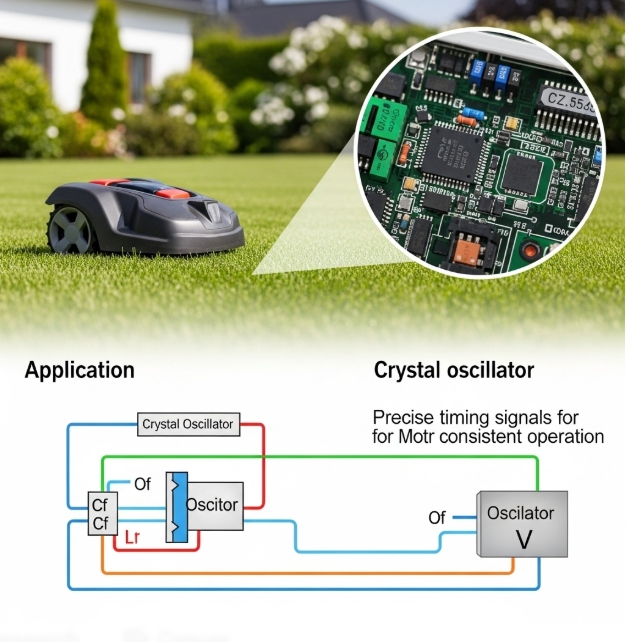
В современных интеллектуальных садовых системах и автономной уличной технике, такой как электрические газонокосилки и роботизированные садовые устройства, кварцевые генераторы Играют важную, но часто недооцениваемую роль. Эти прецизионные компоненты необходимы для поддержания синхронизированной связи, надежной обработки сигналов и стабильной синхронизации в условиях, где неизбежны вибрация, колебания температуры и влажность. В контексте промышленного или потребительского уровня удовлетворительно Для повышения производительности наружной автоматизации роль генераторов выходит далеко за рамки базовой генерации тактовых импульсов.

Кварцевые генераторы служат основой синхронизации для встраиваемых систем, микроконтроллеров и беспроводных коммуникационных модулей, используемых в роботизированных газонокосилках и садовых машинах. Эти устройства часто работают под прямыми солнечными лучами, в условиях переменчивой погоды или на неровной местности, поэтому требуются компоненты тактовой частоты, способные надежно работать в любых условиях. широкий диапазон температур, обычно от -40°C до +85°C и даже выше. Стандартные генераторы могут дрейфовать или выходить из строя в таких условиях, что приводит к сбоям в работе, ошибкам сигнала или нескоординированному управлению движением.
Например, в бесщёточных двигателях постоянного тока (BLDC), используемых для привода колёс или режущих лезвий умных садовых роботов, требуется точное управление с помощью широтно-импульсной модуляции (ШИМ). Это возможно только при стабильность генератора остается нетронутым, несмотря на воздействие окружающей среды.
В отличие от электроники для помещений, уличные роботы, такие как автономные газонокосилки, постоянно подвергаются механическим ударам и вибрации. При стрижке травы или движении по неровной местности вибрации могут нарушить работу чувствительных цепей синхронизации. Виброустойчивые кварцевые генераторы, часто изготавливаемые с использованием прочных керамических или металлических корпусов и герметизированных эпоксидной смолой соединений, спроектированы таким образом, чтобы свести к минимуму механический резонанс, который в противном случае мог бы привести к дрожанию синхронизации или повреждению данных.
Эти осцилляторы обычно следуют строгим MIL-STD-202 или AEC-Q200 Протоколы испытаний для обеспечения эксплуатационной надежности мобильных или полупромышленных систем. Их механическая устойчивость напрямую влияет на долгосрочную удовлетворительная производительность и срок службы интеллектуальных садовых устройств.
Наружная автоматика также должна противостоять высокой влажности, осадкам и росе. Попадание влаги — тихий убийца электронных схем, особенно тех, которые отвечают за целостность высокочастотного сигнала. Чтобы решить эту проблему, влагостойкие кварцевые генераторы Предпочтительны герметичные уплотнения или современные конформные покрытия. Эти защитные свойства предотвращают влияние конденсата на вибрацию кварцевого элемента и замыкание внутренних цепей.
Во встроенных радиочастотных модулях, используемых для Wi-Fi, Bluetooth или других систем связи, воздействие влаги на генератор может привести к потере пакетов, нестабильному соединению или уменьшению дальности связи. Поэтому защита окружающей среды при упаковке генераторов это не только вопрос долговечности, но и предпосылка для бесперебойного подключения.
Электрические садовые роботы часто оснащаются несколькими датчиками — от ультразвуковых, лидаров, GPS до инерциальных измерительных блоков (IMU) — для автономной навигации и предотвращения столкновений. Эти модули используют точно синхронизированные сигналы для определения местоположения, обнаружения кромок газона и планирования эффективных маршрутов скашивания. Кварцевые генераторы с низким фазовым шумом помогают поддерживать согласованность времени во всех этих модулях, обеспечивая возможность принятия решений в режиме реального времени.
Без точных источников частоты объединение данных датчиков становится ненадежным, что приводит к такому поведению, как неточное картографирование или неэффективное отслеживание пути, что отрицательно влияет на производительность системы.
В садовом роботизированном оборудовании с питанием от аккумуляторных батарей энергопотребление является критическим конструктивным ограничением. Маломощные кварцевые генераторыТакие варианты, как термокомпенсированный (TCXO) или микромощные, обеспечивают стабильность функций синхронизации без значительного разряда аккумулятора. Эти генераторы часто используются в часах реального времени (RTC) и циклах сна-бодрствования основного блока управления, позволяя интеллектуальным стратегиям управления питанием увеличивать время работы без подзарядки.
Более того, поддержание стабильность сигнала в течение длительного времени помогает избежать ненужных повторных калибровок или сбоев программного обеспечения, способствуя общему эксплуатационное удовлетворение конечного пользователя.
Кварцевые генераторы, используемые в интеллектуальном садовом оборудовании, таком как электрические газонокосилки и автономные садовые роботы, должны соответствовать высоким требованиям по устойчивости к температурам. устойчивость к вибрации, и защита от влаги. Их роль играет основополагающую роль в обеспечении целостности сигнала, синхронизации и энергоэффективности в этих мобильных наружных платформах. По мере того, как автоматизация сада становится всё более сложной, потребность в надёжных и высокоточных компонентах синхронизации становится всё более острой, что делает кварцевые генераторы незаменимыми для достижения долговременной стабильности. удовлетворительная производительность в реальных приложениях.